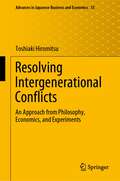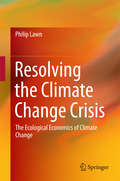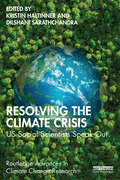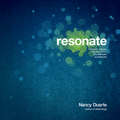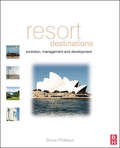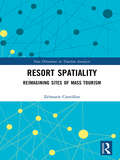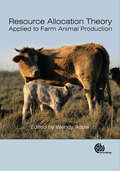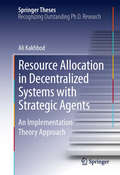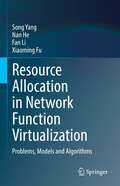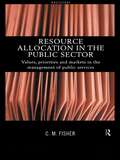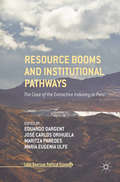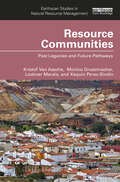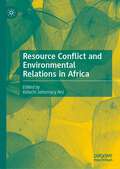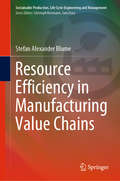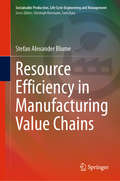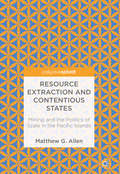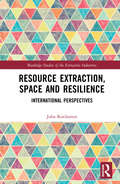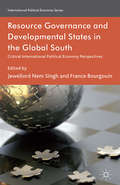- Table View
- List View
Resolving Conflicts at Work
by Warren Bennis Joan Goldsmith Kenneth ClokeHere is a completely updated edition of the best-selling Resolving Conflicts at Work. This definitive and comprehensive work provides a handy guide for resolving conflicts, miscommunications, and misunderstandings at work and outlines the authors' eight strategies that show how the inevitable disputes and divisions in the workplace actually provide an opportunity for greater creativity, productivity, enhanced morale, and personal growth. This new edition includes current case studies that put the focus on leadership, management, and how organizations can design systems to change a culture of avoidance into a culture of creative conflict. The result is a more practical book for today's companies and the people who work in them.
Resolving Intergenerational Conflicts: An Approach from Philosophy, Economics, and Experiments (Advances in Japanese Business and Economics #33)
by Toshiaki HiromitsuThis book is an unprecedented consideration of the challenges of what we can do for generations yet to come. Many growing intergenerational conflicts of interest, such as climate change and fiscal sustainability, are the result of the historically new progress of increasing human power, and the resolution of those conflicts demands a new intergenerational ethic. The book offers fresh new ideas for resolving intergenerational conflicts through the exploration of an entirely new field, conceptualized in philosophy, developed in economics, and tested in experiments. In particular, this work develops the theory of intergenerational cooperation based on a new relationship of direct reciprocity between generations. From experimental results, the possibility of intergenerational cooperation through Kantian categorical imperative is shown. The book also examines the effectiveness of inviting representatives of future generations, which are called "imaginary future generations", into the deliberations for current policy decisions. The original Japanese edition of this book was awarded the 66th Nikkei Prize for Excellent Books in Economic Science. The prize was established in 1958 to contribute to the advancement of academics and knowledge in the fields of economics, management, and accounting, as well as to its general dissemination and application.
Resolving Land Disputes in East Asia
by John Gillespie Hualing FuEconomic development and mass urbanization have unleashed unprecedented levels of land disputes in East Asia. In China and Vietnam especially, courts and other legal institutions struggle to find lasting solutions. It is against this background of legal failure that this book brings together leading scholars to understand how state agencies, land users and land developers imaginatively engage with each other to resolve disputes. Drawing on empirically rich case studies, contributors explore the limits of law and legal institutions in resolving land disputes and reveal insights into how key actors in East Asia understand land disputes. Their studies reveal promising dispute resolution practices and point to the likely ways that states will deal with land disputes in the future.
Resolving Transfer Pricing Disputes
by Eduardo Baistrocchi Ian RoxanVia a global analysis of more than 180 transfer pricing cases from 20 representative jurisdictions, Resolving Transfer Pricing Disputes explains how the law on transfer pricing operates in practice and examines how disputes between taxpayers and tax administrations are dealt with around the world. It has been designed to be an essential complement to the OECD Transfer Pricing Guidelines for Multinational Enterprises and Tax Administrations, which focus on transfer pricing issues but do not refer to specific transfer pricing disputes. All of the transfer pricing cases discussed in the book are linked to the relevant paragraphs of the OECD Guidelines by means of a 'Golden Bridge', namely a table listing the cases according to the paragraphs of the Guidelines to which they refer. It therefore provides examples of the application of the Arm's Length Principle in many settings on all continents.
Resolving the Climate Change Crisis
by Philip LawnThis book explains why the climate change crisis is a symptom of a much larger underlying problem - namely, humankind's predilection with continuous GDP-growth. Given this starting point, the world's high-income nations must begin the transition to a qualitatively-improving steady-state economy and low-income nations must follow suit at some stage over the next 20-40 years. Unless they do, a well-designed emissions protocol will be as useless as the paper it is written on. Adopting an ecological economic approach, this book sets out why we must abandon the goal of continuous growth; how we can do so in a way that improves human well-being; what constitutes a safe atmospheric concentration of greenhouse gases; and what type of emissions protocol and emissions-trading framework is likely to achieve a desirable climate change outcome. Failure of the world's leaders to achieve these goals will not only put future human well-being at risk, it will threaten freedom in the liberal-democratic tradition and international peace.
Resolving the Climate Crisis: US Social Scientists Speak Out (Routledge Advances in Climate Change Research)
by Kristin Haltinner Dilshani SarathchandraThis book brings together a team of renowned social scientists to ask not why climate change is happening, but how we might learn from its human dimensions to raise public and political will to fight against the climate crisis.Despite efforts for mitigation, global emission levels continue to increase annually and the world’s wealthiest nations, including all of the G20 countries, have failed to meet their Paris Climate Goals. In the absence of political will, many have called for individuals to act on climate change by mitigating their own carbon footprint through having fewer children, driving less, using LED lightbulbs, or by becoming vegetarians. While compelling, individual lifestyle changes on this scale are unlikely to prevent climate disaster. Resolving the Climate Crisis presents informed solutions for social change that center human behavior and emotions, political systems, and societal structures. Across a series of concise and accessible chapters, authors explore potential solutions to climate change, addressing topics including Indigenous ecologies, LGBTQ+ community engagement, renewable energy technologies, and climate justice. Their expert engagement with the social and behavioural sciences makes this book not only an essential handbook of climate change solutions but also an innovative model for public-facing social science scholarship.Resolving the Climate Crisis will be an essential resource for students and researchers of climate change, as well as policy makers working to develop meaningful strategies for combatting the climate crisis.
Resonant Leadership
by Annie Mckee Richard BoyatzisThe blockbuster best seller Primal Leadership introduced us to "resonant" leaders--individuals who manage their own and others' emotions in ways that drive success. Leaders everywhere recognized the validity of resonant leadership, but struggled with how to achieve and sustain resonance amid the relentless demands of work and life. Now, Richard Boyatzis and Annie McKee provide an indispensable guide to overcoming the vicious cycle of stress, sacrifice, and dissonance that afflicts many leaders. Drawing from extensive multidisciplinary research and real-life stories, Resonant Leadership offers a field-tested framework for creating the resonance that fuels great leadership. Rather than constantly sacrificing themselves to workplace demands, leaders can manage the cycle using specific techniques to combat stress, avoid burnout, and renew themselves physically, mentally, and emotionally. The book reveals that the path to resonance is through mindfulness, hope, and compassion and shows how intentionally employing these qualities creates effective and enduring leadership. Great leaders are resonant leaders. Resonant Leadership offers the inspiration--and tools--to spark and sustain resonance in ourselves and in those we lead.
Resonate
by Nancy DuarteReveals the underlying story form of all great presentations that will not only create impact, but will move people to actionPresentations are meant to inform, inspire, and persuade audiences. So why then do so many audiences leave feeling like they've wasted their time? All too often, presentations don't resonate with the audience and move them to transformative action.Just as the author's first book helped presenters become visual communicators, Resonate helps you make a strong connection with your audience and lead them to purposeful action. The author's approach is simple: building a presentation today is a bit like writing a documentary. Using this approach, you'll convey your content with passion, persuasion, and impact.Author has a proven track record, including having created the slides in Al Gore's Oscar-winning An Inconvenient TruthFocuses on content development methodologies that are not only fundamental but will move people to actionUpends the usual paradigm by making the audience the hero and the presenter the mentorShows how to use story techniques of conflict and resolutionPresentations don't have to be boring ordeals. You can make them fun, exciting, and full of meaning. Leave your audiences energized and ready to take action with Resonate.
Resort Destinations
by Bruce PrideauxDestination management and resort development and planning are strong core areas in the final year of most undergraduate degrees and a popular area of study at postgraduate level. Using original case studies based on his own research, Resort Destinations uses examples from Australia's Gold Coast, Britain's Brighton, USA's Las Vegas, as well as Hong Kong, New Zealand and the Caribbean.
Resort Spatiality: Reimagining Sites of Mass Tourism (New Directions in Tourism Analysis)
by Zelmarie CantillonThis book theorises resorts as distinct kinds of urban milieux, capturing the complexity of destinations famous for ‘sun, sand and sex’ mass tourism. Drawing on qualitative field research (participant observation, interviews and photography), the book discusses examples from six international resort destinations spread across four continents: the Gold Coast, Australia; Phuket and Koh Phangan, Thailand; Cancún, Mexico; Miami, USA; and Ibiza, Spain. The book reviews the material and symbolic production of lived spaces in these resorts, considering the mutually constitutive, mutually transformative relations between their spatial formations, built environments, popular imaginaries, representations, narratives of identity, rhythms, and the experiences and practices of both tourists and locals. In doing so, it argues for more nuanced ways of conceptualising tourism, globalisation and spatiality, reimagining how these phenomena unfold in lived spaces. Taking a cultural studies approach to urban analysis, the book demonstrates the value in embracing complexity, fluidity, partiality and uncertainty. It will be of interest to students and researchers of tourism, geography, cultural studies, development studies, anthropology and sociology.
Resorts and Ports
by Peter Borsay John K. WaltonHistories of seaports and coastal resorts have usually been kept in separate compartments. This book brings them together and looks at how resort development affected historic ports during the rise and development of the seaside holiday in Europe from the 18th century to the 20th, and what the attributes of ports (fishing, harbour crafts, the whiff of the exotic, fishermen's homes and families) contributed to the attractions of resorts. Case-studies drawn from across Europe, from Wales and the Netherlands to Norway, Latvia and Spain, bring original perspectives to bear on these histories and relationships, and consider their influence on seaside heritage and regeneration at a time when coastal settlements are increasingly using their past to secure their future. The book will interest academics in tourism studies, history, geography and cultural studies, as well as provide essential information and analysis for policy-makers in coastal regeneration.
Resource Accounting for Sustainability Assessment: The Nexus between Energy, Food, Water and Land Use (Routledge Explorations in Sustainability and Governance)
by Mario Giampietro Richard J. Aspinall Jesus Ramos-Martin Sandra G.F. BukkensThe demands placed on land, water, energy and other natural resources are exacerbated as the world population continues to increase together with the expectations of economic growth. This, combined with concerns over environmental change, presents a set of scientific, policy and management issues that are critical for sustainability. Resource Accounting for Sustainability Assessment: The nexus between energy, food, water and land use offers an approach for multi-scale, integrated assessment of this nexus. It presents a comprehensive and original method of resource accounting for integrated sustainability assessments. The approach is illustrated with three detailed case studies: the islands of Mauritius, the Indian state of Punjab, and the energy economy of South Africa. The relationships between flows of goods, services and materials in these case studies offer valuable insights. The book provides a much needed quality control on the information used in deliberative processes about policy and planning activities. This innovative book will be of interest to researchers, students and practitioners in the fields of sustainability science, international development, industrial ecology, sustainable resource management, geography and ecological economics.
Resource Allocation Theory Applied to Farm Animal Production
by Wendy Mercedes RauwThis book describes resource allocation patterns in natural populations, the costs, preferences and trade-offs of maintenance, growth, the consequences of selection for high production efficiency in livestock species, methods that can be used to quantify resource allocation patterns, and the application of resource allocation theory to improve animal production and wellbeing.
Resource Allocation in Decentralized Systems with Strategic Agents
by Ali KakhbodThis thesis presents a significant contribution to decentralized resource allocation problems with strategic agents. The study focused on three classes of problems arising in communication networks. (C1). Unicast service provisioning in wired networks. (C2). Multi-rate multicast service provisioning in wired networks. (C3). Power allocation and spectrum sharing in multi-user multi-channel wireless communication systems. Problems in (C1) are market problems; problems in (C2) are a combination of markets and public goods; problems in (C3) are public goods. Dr. Kakhbod developed game forms/mechanisms for unicast and multi-rate multicast service provisioning that possess specific properties. First, the allocations corresponding to all Nash equilibria (NE) of the games induced by the mechanisms are optimal solutions of the corresponding centralized allocation problems, where the objective is the maximization of the sum of the agents' utilities. Second, the strategic agents voluntarily participate in the allocation process. Third, the budget is balanced at the allocations corresponding to all NE of the game induced by the mechanism as well as at all other feasible allocations. For the power allocation and spectrum sharing problem, he developed a game form that possesses the second and third properties as detailed above along with a fourth property: the allocations corresponding to all NE of the game induced by the mechanism are Pareto optimal. The thesis contributes to the state of the art of mechanism design theory. In particular, designing efficient mechanisms for the class of problems that are a combination of markets and public goods, for the first time, have been addressed in this thesis. The exposition, although highly rigorous and technical, is elegant and insightful which makes this thesis work easily accessible to those just entering this field and will also be much appreciated by experts in the field.
Resource Allocation in Network Function Virtualization: Problems, Models and Algorithms
by Song Yang Fan Li Xiaoming Fu Nan HeNetwork Function Virtualization (NFV) has recently attracted considerable attention from both research and industrial communities. Numerous papers have been published regarding solving the resource- allocation problems in NFV, from various perspectives, considering different constraints, and adopting a range of techniques. However, it is difficult to get a clear impression of how to understand and classify different kinds of resource allocation problems in NFV and how to design solutions to solve these problems efficiently.This book addresses these concerns by offering a comprehensive overview and explanation of different resource allocation problems in NFV and presenting efficient solutions to solve them. It covers resource allocation problems in NFV, including an introduction to NFV and QoS parameters modelling as well as related problem definition, formulation and the respective state-of-the-art algorithms.This book allows readers to gain a comprehensive understanding of and deep insights into the resource allocation problems in NFV. It does so by exploring (1) the working principle and architecture of NFV, (2) how to model the Quality of Service (QoS) parameters in NFV services, (3) definition, formulation and analysis of different kinds of resource allocation problems in various NFV scenarios, (4) solutions for solving the resource allocation problem in NFV, and (5) possible future work in the respective area.
Resource Allocation in the Public Sector: Values, Priorities and Markets in the Management of Public Services
by Colin FisherIn the public sector at the moment resources are scarce - or at the very least finite and limited - how they are allocated is therefore of crucial importance.This book analyses this process and examines the competing values that underlie the public service ethic, including the role of markets and quasi-markets, in the delivery of public services.Topics discussed include:* whether people should be denied the public services they need because public bodies are short of money* what balance we should strike between markets and public organisations to provide public services* whether the use of markets has gone too far and whether we need to return to a public service ethic
Resource Booms and Institutional Pathways
by Eduardo Dargent Maritza Paredes José Carlos Orihuela María Eugenia UlfeThis book analyses the institutional development that the Peruvian state has undergone in recent years within a context of rapid extractive industry expansion. It addresses the most important institutional state transformations produced directly by natural resources growth. This includes the construction of a redistributive law with the mining canon; the creation of a research canon for public universities; the development of new institutions for environmental regulation; the legitimation of state involvement in the function of prevention and management of conflicts; and the institutionalization and dissemination of practices of participation and local consultation.
Resource Communities: Past Legacies and Future Pathways (Earthscan Studies in Natural Resource Management)
by Lochner Marais Kristof Van Assche Monica Gruezmacher Xaquin Perez-SindinThis book provides an innovative approach to understanding the governance of resource communities, by showcasing how the past and present informs the future. Resource communities have complicated relationships with the past, and this makes their relationship with the future, and the future itself, also complicated. The book digs deeply into the myriad legacies left by a history of resource extraction in a community and makes use of interdisciplinary and transdisciplinary perspectives to understand the complex issues being faced by a range of different communities that are reliant on different types of resources across the world. From coal and gold mining, to fishing towns and logging communities, the book explores the legacies of boom and bust economies, social memory, trauma and identity, the interactions between power and knowledge and the implications for adaptive governance. Balancing conceptual and theoretical understandings with empirical and practical knowledge of resource communities, natural resource use and social-ecological relationships, the book argues that solutions for individual communities need to be embraced in the community and not just in the perspectives of visiting experts. Linking the past, present and futures of resource communities in a new way, the book concludes by providing practical recommendations for breaking open dependencies on the past, including deepening awareness of the social, economic and environmental contexts, establishing strong governance and developing community strategies, plans and policies for the future. This book will be of great interest to students and scholars of natural resource governance and management, extractive industries, environmental policy, community planning and development, environmental geography and sustainable development, as well as policymakers involved in supporting community development in natural resource-dependent communities across the world.
Resource Conflict and Environmental Relations in Africa
by Kelechi Johnmary AniThe book discusses the failure of many African governments in providing the social needs of the masses, thereby placing the citizenry on the desperate quest for economic resources. Unfortunately, in many African States, mineral resources are owned, explored and marketed by the machinery of the state. The problem arises when the masses begin to challenge state access and ownership of resources that are domiciled within their ancestral land, communities, and constituencies. Often the challenge and resistance to state ownership of resources is generated by communal or group sense of exploitation, negligence and widespread poverty in the face of high resource endowment and waste by the government officials. Paradoxically, in Niger Delta of Nigeria, as discussed in the book, the state has unleashed unlimited might upon all social groups and agitators, thereby leading to the increased act of taking arms by such groups. When the informal resource agitators succeed in arming themselves, they begin to demand social and environmental justice, thereby leading to mass armed conflict between them and the government security agencies. Sometimes, the confrontation could be between them and other rival local resource actors in the informal sector of their country’s economy bearing in mind that the resources within their jurisdiction have become the central determinant of national commonwealth. It is at that state of desperado to control access, extraction and sale of natural resources in a State, by different armed groups that the process of natural resources extraction qualifies as the most visible cause of conflicts and crises around the African continent that is the centrepiece of the book. This is quite understandable given that mineral resource is a gift of nature; and nature is that phenomenon that every human, group and nation claim to represent, or, believe to represent them.
Resource Curse or Cure ?
by Martin Brueckner Angela Durey Robyn Mayes Christof PforrGlobalisation and rapid social and environmental change in recent decades have brought into sharper focus not only the benefits but also the costs of economic development. The once assumed link between economic development and societal well-being is being increasingly questioned in the face of growing social and environmental problems and unfulfilled expectations concerning political and commercial decision-makers. The orthodox development dogma is being tested in particular in resource-based economies such as Western Australia, where globalisation pressures and the concomitant rise in the demand for natural resources highlight the difficulties of effectively balancing broader societal interests with those of industry and the state. This book provides a critical review of the socio-political, environmental and cultural state of play in Western Australia, offering an analysis of how resource-based developments are shaping the state and its people.
Resource Efficiency in Manufacturing Value Chains (Sustainable Production, Life Cycle Engineering and Management)
by Stefan Alexander BlumeThis book presents a concept for fostering resource efficient manufacturing. The protection of our environment demands a more responsible use of natural resources, and a higher degree of transparency along manufacturing value chains will be required in order to make significant advances in this context. Industrial decision makers must be provided with adequate methods and tools to simultaneously and systematically pursue technical, economic and environmental targets. Building on established and complementary methods, such as material and energy flow analysis (MEFA), value stream mapping (VSM), life cycle costing (LCC) and environmental life cycle assessment (LCA), this book introduces a concept that allows a holistic modeling and multi-dimensional performance assessment of manufacturing systems on different levels – from processes up to entire value chains and product life cycles. It also demonstrates the application of the concept using two case studies from the metal mechanic industry.
Resource Efficiency in Manufacturing Value Chains (Sustainable Production, Life Cycle Engineering and Management)
by Stefan Alexander BlumeThis book presents a concept for fostering resource efficient manufacturing. The protection of our environment demands a more responsible use of natural resources, and a higher degree of transparency along manufacturing value chains will be required in order to make significant advances in this context. Industrial decision makers must be provided with adequate methods and tools to simultaneously and systematically pursue technical, economic and environmental targets. Building on established and complementary methods, such as material and energy flow analysis (MEFA), value stream mapping (VSM), life cycle costing (LCC) and environmental life cycle assessment (LCA), this book introduces a concept that allows a holistic modeling and multi-dimensional performance assessment of manufacturing systems on different levels – from processes up to entire value chains and product life cycles. It also demonstrates the application of the concept using two case studies from the metal mechanic industry.
Resource Extraction and Contentious States: Mining And The Politics Of Scale In The Pacific Islands
by Matthew G. AllenThis Pivot offers a comprehensive cross-country study of the effects of large-scale resource extraction in Asia Pacific, considering how large-scale extractive industries engender contentious social, political and economic questions. Addressing the strong association in Melanesia between extractive resource industries and a spectrum of violence ranging from interpersonal to collective forms, it questions whether islands are particularly potent spaces for the contentious politics that attend enclave economies. The book brings island studies literature into a closer conversation with political and economic geography, demonstrating that islands provide rich spaces for the investigation of the socio-spatial relations at the heart of human geography’s theoretical cannon. The book also has a real-world policy edge, as the sustained and growing dominance of extractive industries, in concert with the highly contentious politics that they engender, places them at the centre of efforts to understand state formation, political reordering and the on-going negotiation of political settlements of various types throughout post-colonial Melanesia. It considers how extractive resource industries can shape processes of state formation, shedding new light on Melanesia’s resource curse.
Resource Extraction, Space and Resilience: International Perspectives (Routledge Studies of the Extractive Industries and Sustainable Development)
by Juha KotilainenWhile much of the current research on the extractive industries and their socio-environmental impacts is region specific, Resource Extraction, Space and Resilience: International Perspectives critically explores the current state of the extractive industries sector from a uniquely global perspective. The book introduces a more dynamic idea of sustainability in evaluating mineral extraction and its impacts, and provides a spatialized understanding of the evolution of the extractive industries to help visualise the interlinkages across space, regions and scales. Professor Kotilainen responds to these theoretical challenges by analysing the potential for resilience of mining activities from multiple perspectives across scales, exploring why it is only possible to achieve temporary balance and stability for the whole resource extraction system. Taking a global perspective, the book explores the interlinkages of the industry, investigates the similarities and differences in how the industry operates and examines the social and environmental impacts it has. By providing an explicitly theoretically informed analysis of the state of the extractive industries, this text will appeal to a wide range of scholars with an interdisciplinary interest in the extractive industries and natural resource management, including human geographers and social scientists with a focus on the relations of humans and societies with their physical environments.
Resource Governance and Developmental States in the Global South
by Jewellord Nem Singh F. BourgouinThe political economy landscape has shifted as multinational corporations increase their investment efforts, changing the geographies of extraction. The contributors make the argument for the need of new theoretical perspectives anchored in critical political economy to address structural dynamics in the global industry.

